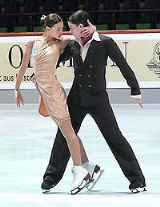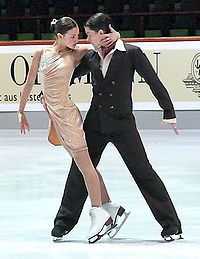
Original dance
Encyclopedia
The original dance was a segment of an ice dancing
competition
. It was usually the second of three programs, sandwiched between the compulsory dances
and the free dance
. Until 1994, it was known as the original set pattern dance (OSP). Following the 2009-10 season, the original dance was discontinued and replaced by the short dance
(SD).
Each season, the International Skating Union
designated a rhythm or set of rhythms that all dancers must perform to in the original dance, but unlike the compulsory dances, the competitors chose their own music (within a specified tempo range) and choreography. The original dance could be compared to the short program in singles and pairs. The length of the program was shorter than the free dance, and the skaters had more rules to which to adhere. The dance had to be choreographed so that the steps did not cross the midline of the rink. There were certain exceptions for this rule that took into account required step sequences such as the diagonal footwork sequence. Closed partnering positions and close skating was also important for the original dance.
 The following is a list of senior level original dance rhythms.
The following is a list of senior level original dance rhythms.
Ice dancing
Ice dancing is a form of figure skating which draws from the world of ballroom dancing. It was first competed at the World Figure Skating Championships in 1952, but did not become a Winter Olympic Games medal sport until 1976....
competition
Figure skating competition
-International:* International competitions sanctioned by the International Skating Union. These competitions are held using ISU rules; skaters are entered by their respective national skating federations....
. It was usually the second of three programs, sandwiched between the compulsory dances
Compulsory dances
Compulsory dances, now called pattern dance in ice dancing, are a part of ice dancing and artistic roller skating in which all the couples perform the same standardized steps and holds to music of a specified tempo. One or more compulsory dances were usually skated as the first phase of ice dancing...
and the free dance
Free dance (figure skating)
The free dance is a part of an ice dancing competition. It is the second part of the competition to be contested, after the short dance.-Structure and content:...
. Until 1994, it was known as the original set pattern dance (OSP). Following the 2009-10 season, the original dance was discontinued and replaced by the short dance
Short dance
The short dance is a segment of an ice dancing competition. It was approved by the June 2010 International Skating Union congress and instituted beginning in the 2010–2011 figure skating season...
(SD).
Each season, the International Skating Union
International Skating Union
The International Skating Union is the international governing body for competitive ice skating disciplines, including figure skating, synchronized skating, speed skating, and short track speed skating. It was founded in Scheveningen, Netherlands in 1892, making it one of the oldest international...
designated a rhythm or set of rhythms that all dancers must perform to in the original dance, but unlike the compulsory dances, the competitors chose their own music (within a specified tempo range) and choreography. The original dance could be compared to the short program in singles and pairs. The length of the program was shorter than the free dance, and the skaters had more rules to which to adhere. The dance had to be choreographed so that the steps did not cross the midline of the rink. There were certain exceptions for this rule that took into account required step sequences such as the diagonal footwork sequence. Closed partnering positions and close skating was also important for the original dance.
List of original dance rhythms by season

| Season | Rhythm |
|---|---|
| 1994–1995 | Quickstep Quickstep The quickstep is a light-hearted member of the standard ballroom dances. The movement of the dance is fast and powerfully flowing and sprinkled with syncopations. The upbeat melodies that quickstep is danced to make it suitable for both formal and informal events... |
| 1995–1996 | Paso Doble |
| 1996–1997 | Tango Tango (dance) Tango dance originated in the area of the Rio de la Plata , and spread to the rest of the world soon after.... |
| 1997–1998 | Jive Jive (dance) In Ballroom dancing, Jive is a dance style in 4/4 time that originated in the United States from African-Americans in the early 1930s. It was originally presented to the public as 'Jive' in 1934 by Cab Calloway. It is a lively and uninhibited variation of the Jitterbug, a form of Swing dance... |
| 1998–1999 | Waltz Waltz The waltz is a ballroom and folk dance in time, performed primarily in closed position.- History :There are several references to a sliding or gliding dance,- a waltz, from the 16th century including the representations of the printer H.S. Beheim... |
| 1999–2000 | Latin Combination: Merengue Merengue (dance) Merengue El camino1ro de Secundaria-In popular culture:* Merengue was mentioned as a song performed between Babs and Charlie in the song by Steely Dan.... , Cha Cha Cha-cha-cha (dance) The Cha-cha-cha is the name of a dance of Cuban origin.It is danced to the music of the same name introduced by Cuban composer and violinist Enrique Jorrín in 1953... , Samba Samba Samba is a Brazilian dance and musical genre originating in Bahia and with its roots in Brazil and Africa via the West African slave trade and African religious traditions. It is recognized around the world as a symbol of Brazil and the Brazilian Carnival... , Mambo Mambo (dance) Mambo .In the late 1940s, Perez Prado came up with the dance for the mambo music and became the first person to market his music as "mambo". After Havana, Prado moved his music to Mexico, where his music and the dance was adopted. The original mambo dance was characterized by freedom and... , Rumba Rumba (dance) Rumba is a dance term with two quite different meanings.In some contexts, "rumba" is used as shorthand for Afro-Cuban rumba, a group of dances related to the rumba genre of Afro-Cuban music. The most common Afro-Cuban rumba is the guaguancó... |
| 2000–2001 | Charleston Charleston (dance) The Charleston is a dance named for the harbor city of Charleston, South Carolina. The rhythm was popularized in mainstream dance music in the United States by a 1923 tune called "The Charleston" by composer/pianist James P. Johnson which originated in the Broadway show Runnin' Wild and became one... , Foxtrot, Quickstep Quickstep The quickstep is a light-hearted member of the standard ballroom dances. The movement of the dance is fast and powerfully flowing and sprinkled with syncopations. The upbeat melodies that quickstep is danced to make it suitable for both formal and informal events... and March |
| 2001–2002 | Tango Tango (dance) Tango dance originated in the area of the Rio de la Plata , and spread to the rest of the world soon after.... , Flamenco Flamenco Flamenco is a genre of music and dance which has its foundation in Andalusian music and dance and in whose evolution Andalusian Gypsies played an important part.... , Paso Doble and Spanish Waltz |
| 2002–2003 | Memories of a Grand Ball: Waltz Waltz The waltz is a ballroom and folk dance in time, performed primarily in closed position.- History :There are several references to a sliding or gliding dance,- a waltz, from the 16th century including the representations of the printer H.S. Beheim... , Polka Polka The polka is a Central European dance and also a genre of dance music familiar throughout Europe and the Americas. It originated in the middle of the 19th century in Bohemia... , March, and Gallop |
| 2003–2004 | Swing Combo: Jive Swing (genre) Swing music, also known as swing jazz or simply swing, is a form of jazz music that developed in the early 1930s and became a distinctive style by 1935 in the United States... , Boogie Woogie, Jitterbug, Rock N' Roll and Blues |
| 2004-2005 | Foxtrot, Quickstep Quickstep The quickstep is a light-hearted member of the standard ballroom dances. The movement of the dance is fast and powerfully flowing and sprinkled with syncopations. The upbeat melodies that quickstep is danced to make it suitable for both formal and informal events... , Charleston Charleston (dance) The Charleston is a dance named for the harbor city of Charleston, South Carolina. The rhythm was popularized in mainstream dance music in the United States by a 1923 tune called "The Charleston" by composer/pianist James P. Johnson which originated in the Broadway show Runnin' Wild and became one... |
| 2005–2006 | Latin Combination: Merengue Merengue (dance) Merengue El camino1ro de Secundaria-In popular culture:* Merengue was mentioned as a song performed between Babs and Charlie in the song by Steely Dan.... , Cha Cha Cha-cha-cha (dance) The Cha-cha-cha is the name of a dance of Cuban origin.It is danced to the music of the same name introduced by Cuban composer and violinist Enrique Jorrín in 1953... , Samba Samba Samba is a Brazilian dance and musical genre originating in Bahia and with its roots in Brazil and Africa via the West African slave trade and African religious traditions. It is recognized around the world as a symbol of Brazil and the Brazilian Carnival... , Mambo Mambo (dance) Mambo .In the late 1940s, Perez Prado came up with the dance for the mambo music and became the first person to market his music as "mambo". After Havana, Prado moved his music to Mexico, where his music and the dance was adopted. The original mambo dance was characterized by freedom and... , Rumba Rumba (dance) Rumba is a dance term with two quite different meanings.In some contexts, "rumba" is used as shorthand for Afro-Cuban rumba, a group of dances related to the rumba genre of Afro-Cuban music. The most common Afro-Cuban rumba is the guaguancó... |
| 2006–2007 | Tango Tango (dance) Tango dance originated in the area of the Rio de la Plata , and spread to the rest of the world soon after.... |
| 2007–2008 | Folk Folk music Folk music is an English term encompassing both traditional folk music and contemporary folk music. The term originated in the 19th century. Traditional folk music has been defined in several ways: as music transmitted by mouth, as music of the lower classes, and as music with unknown composers.... , Country Country music Country music is a popular American musical style that began in the rural Southern United States in the 1920s. It takes its roots from Western cowboy and folk music... |
| 2008-2009 | Rhythms of the 1920s, 1930s, and 1940s |
| 2009–2010 | Folk Folk music Folk music is an English term encompassing both traditional folk music and contemporary folk music. The term originated in the 19th century. Traditional folk music has been defined in several ways: as music transmitted by mouth, as music of the lower classes, and as music with unknown composers.... , Country Country music Country music is a popular American musical style that began in the rural Southern United States in the 1920s. It takes its roots from Western cowboy and folk music... |
| 2010–2011 | The original dance rhythm of this season was set to be "Rhythms and Dances of the 1950's, 1960's or 1970's" However, the original dance was discontinued, and the short dance Short dance The short dance is a segment of an ice dancing competition. It was approved by the June 2010 International Skating Union congress and instituted beginning in the 2010–2011 figure skating season... instituted in its stead. |

